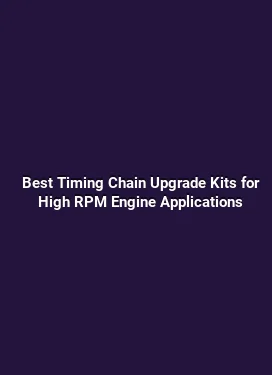Brian Crower Stage 2 Camshafts on Honda K20: Engine Management & Tuning
Upgrading to Brian Crower Stage 2 camshafts represents a meaningful performance improvement for Honda K-series builds, especially those focused on high-revving naturally aspirated (NA) power or forced induction applications. The Stage 2 profile is designed to increase intake and exhaust valve lift and duration compared to Stage 1, delivering stronger mid and upper-range torque while preserving a practical idle and streetability. This guide walks through the mechanical considerations, precise installation steps, and tuning strategies needed to maximize reliability and horsepower gains on a K20 platform.
Understanding the Stage 2 Profile and its Impact on the K20 Engine

The Brian Crower Stage 2 camshafts typically feature a higher lift and altered duration and ramp geometry than Stage 1. For a K20, this translates to a broader Read More torque band with improvements in high-RPM breathing. However, the increased lift and timing shifts demand careful attention to valve train clearance, piston-to-valve interactions, oiling, and engine management to avoid detonation, misfires, or piston damage at high RPMs.
Key aspects to consider include the cam lobe profiles for both intake and exhaust, the valve lift increase, the overlap duration, and how these change the dynamic compression ratio as the cam rotates. In practical terms, a Stage 2 cam setup benefits from a tuned air intake, optimized exhaust scavenging, and a matching ECU map that can manage the altered airflow, fuel requirements, and ignition timing across the engine’s RPM range.
Mechanical Preparations Before Installation
Proper preparation is essential to ensure the Stage 2 cam installation yields consistent performance without compromising reliability. Begin by verifying the engine block, cylinder head, and valve train components are within serviceable tolerances and free from excessive wear. A clean, dry workspace helps prevent debris ingress into the cam journals and cylinder head ports.
Important checks include inspecting camshafts, followers, and cam phasers (if equipped) for scoring or wear. For K20 engines with rocker-arm configurations, ensure rocker geometry aligns with the new cam lobes to prevent binding or excessive lash. Stock valve springs may be marginal for higher lift and rate demands; evaluate whether replacement with stiffer springs is recommended by BC for your specific build and rpm targets. It is also prudent to verify head gasket integrity and to consider upgrading hardware where recommended by BC documentation or a trusted tuner.
Clearance and Compatibility Considerations

With Stage 2 cams, increased valve lift can reduce piston-to-valve clearance at certain crank angles. A meticulous approach includes performing a piston-to-valve clearance check or using a comprehensive clearance map informed by the specific K20 variant (K20A2, K20A3, K20A4, K20C1, etc.). If the clearance is marginal, you may need to adjust the cam timing slightly or choose a variant within the Stage 2 lineup that preserves adequate clearance while delivering the desired performance. It is essential to also verify timing belt or chain compatibility with the revised cam phasing behavior and ensure the camshaft seals are correctly installed to prevent oil leaks post-installation.
Disassembly and Camshaft Installation Steps
Approaching the installation with a methodical, step-by-step process minimizes risk and ensures alignment with the engine’s tolerances. The Honda K-series uses a robust configuration that responds well to careful torque control and precise timing alignment.
First, disconnect the battery and remove the intake system, valve covers, and any accessories that obstruct access to the cam gears and timing components. Mark the timing marks on the cam sprockets and chain/belt with a non-permanent marker for reference, then proceed to release chain tensioners and remove the timing cover. With the camshafts removed, measure the oil clearance and verify the cam bearings’ cleanliness before installing the new Stage 2 cams. Carefully seat the new cams into the head, ensuring they sit flush in their journal bores and that the cam gears align precisely with the crankshaft timing marks. After seating, reinstall the timing chain or belt with the correct tensioning procedure and recheck timing marks to ensure rotation yields the correct valve timing at top dead center.
During final assembly, ensure valve cover gaskets and seals are properly seated and that any aggressive lobe ramps are not forcing excessive side-loading on the cam bearings. Reinstall the valve covers with the correct torque pattern to avoid leaks. A careful final check includes turning the engine by hand through a few cycles to confirm smooth cam action without binding or unusual resistance.
Initial Start and Break-In Procedure
Upon first start after cam installation, perform a cautious break-in procedure. Start with a conservative idle, and gradually bring the engine to operating temperature. For the break-in, avoid high RPM and heavy load for the first 20–30 minutes of operation. This allows the cam lobes, followers, and lifters to seat gradually and establish stable oil film coverage across the cam journals. Use a high-quality engine oil recommended for high-performance applications, and keep a diligent eye on oil pressure and temperature during the break-in window. After initial warm-up, perform short, varied RPM trials to ensure oil pickup and lubrication are consistent across the rev range before returning to normal driving patterns.
Tuning Foundations: How to Manage Air, Fuel, and Spark
Engine management becomes the critical element when switching to a more aggressive cam profile. A Stage 2 setup requires recalibrating air-fuel mixtures, ignition timing, and idle control to maintain safe and efficient combustion under higher lift and altered timing. The tuning strategy should maximize power while preserving drivetrain reliability and emissions compliance where applicable.
Begin with a robust baseline map that respects the stock fuel and ignition targets but accommodates the increased airflow from the Stage 2 cams. In naturally aspirated builds, the emphasis is on optimizing intake velocity, air density at higher RPM, and controlling detonation risk through refined ignition timing. For boosted configurations, manage boost-driven air mass with a correspondingly adjusted fuel curve and ignition table to prevent knock onset during high-boost operation.
Fueling Strategy: AFR Targets and Open-Loop vs Closed-Loop
With cam changes, idle stability can be affected due to altered cam phasing and overlap. A steady, positive idle generally benefits from a slightly enriched air-fuel ratio (AFR) as the engine learns the new breathing characteristics. During the stability phase, prefer a closed-loop operation at light to moderate load and maintain an open-loop map for wide-open throttle (WOT) where a dedicated fuel table governs the mixture. The exact AFR targets depend on the engine’s displacement, compression, turbo or NA setup, and the cam’s lift. A practical approach is to start with a conservative AFR near stoichiometry during cruising and enrich progressively under higher RPM/loads to maintain knock resistance and torque delivery.
Ignition Timing: Advancing or Retarding for Performance
Stage 2 cams typically favor slightly retarded timing at lower RPM to preserve idle quality and prevent misfires, while advancing timing at higher RPM can help extract peak horsepower and torque from the additional lift. A tuning strategy involves building a timing map that keeps base timing within safe limits on the low end, then progressively advances timing as RPM climbs, ensuring detonation margins remain robust. It is essential to monitor knock sensor feedback and avoid aggressive timing shifts that compromise engine health. Fine-tuning must be complemented by a reliable knock control threshold and a safeguard against timing pull under varying ambient conditions.
Valvetrain Dynamics and Supporting Upgrades
Because Stage 2 cams modify the dynamics of valve closure and opening speeds, support components should be aligned with the new demand profile. Valve springs, retainers, and possibly the cylinder head hardware should be evaluated for compatibility with the higher lift and altered ramp rates. In some cases, upgrading springs to a higher seat pressure and improved dampening helps maintain stable valve control across the rpm spectrum. Ensure rocker arms or cam followers are compatible with the new lobe geometry, and verify the compatibility of the cam bearings with your head castings. A lubrication plan that reinforces oil delivery to the camshaft area—especially under high-RPM operation—contributes to durability and consistent performance.
Diagnostics and Monitoring
During the tuning phase, implement thorough data logging to capture RPM, manifold pressure, air-fuel ratio, ignition timing, fuel trim, knock events, and oil temperature. A wideband O2 sensor paired with a capable ECU or standalone harness provides real-time feedback that informs safe advancement of timing and fuel input. Regularly review camshaft-related wear indicators, such as valve guide temperatures and lifter wear indicators, to preemptively address potential issues before they escalate into failures.
Additionally, verify the heat management of the intake and exhaust systems. With higher lift profiles, the intake air may heat up more quickly in a hot climate or under sustained high-RPM operation. Implement a calibrated cooling strategy and ensure the cooling system maintains consistent temperatures to prevent heat soak from diminishing performance during long pulls on a dyno or track session.
ECU Options and Calibration Pathways
Choosing the right ECU strategy is crucial for translating mechanical upgrades into measurable performance. Many K-series enthusiasts opt for a programmable engine management solution or a reflashed factory ECU to accommodate the Stage 2 cam profile. Common routes include standalone ECUs, Hondata, or K-Tuned-compatible mappings that offer robust support for variable valve timing, if applicable, and precise fuel and ignition control across the RPM range. A well-supported platform provides flexible spark timing curves, custom fuel tables, and safe startup and idle control tuned for the Stage 2 cam profile.
When configuring the ECU, start with a conservative idle map and gradually expand the WOT fuel and timing windows while monitoring knock and exhaust gas temperatures. For forced induction, include boost compensation to account for added air mass and adjust the wastegate target to avoid over-boosting. In naturally aspirated builds, focus on optimizing the volumetric efficiency curve and ensuring torque delivery remains linear and broad across the RPM range. Always perform calibration on a dynamometer or a closed track with proper safety oversight to validate performance improvements and engine health under load.
Tune Validation and Fine-Tuning Practices
After initial dyno runs and road testing, use data-driven adjustments to refine the map. Observe the AFR stability across gear changes and track any lean or rich pockets that appear at different RPM or throttle positions. Fine-tuning typically involves small increments in ignition timing and fuel enrichment at specific RPM bands to maintain a smooth torque curve and to prevent detonation. It is also common to adjust idle fuel and timing to accommodate the cam’s overlap, ensuring a stable idle without sacrificing response when returning to idle from driving maneuvers.
Remember that tuning is an iterative process. Each change should be validated in both steady-state and transient conditions to ensure reliability across real-world driving scenarios. With Stage 2 cams, patience and methodical validation yield the most reliable and measurable gains in horsepower and torque across the rev range.
Track Readiness and Practical Considerations
For track-oriented builds, ensure the cooling system, oiling strategy, and fuel delivery are aligned with the higher performance profile. A well-tuned Stage 2 setup can unlock significant horsepower, but track reliability depends on consistent fuel delivery, stable timing, and robust lubrication under sustained high-RPM operation. Periodic maintenance after track sessions—including oil and filter changes with a high-performance oil grade—helps preserve the life of the camshaft and valve train components. Track-ready variables, such as tire choice and suspension setup, complement the engine’s revised breathing and power delivery, ensuring the car remains controllable and predictable at the limit.
This installation and tuning pathway emphasizes a holistic approach where mechanical upgrades, engine management, and vehicle dynamics work in harmony. With careful planning, precise installation, and disciplined tuning, the Honda K20 platform can realize meaningful gains in power, responsiveness, and driving enjoyment while maintaining day-to-day drivability and reliability.






